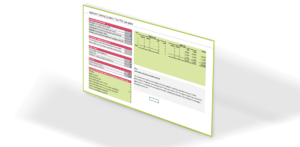3 ways to measure recruitment software ROI
If you’re investing in a new online recruitment system, it’s essential that you can measure your recruitment software ROI.
Whether you’re in the process of building a business case or are one of the decision makers and about to select a new ATS, you need to be sure that you will see some Return on Investment.
So how can you accurately measure your recruitment software ROI?
1. Your organisational information
Hires per annum
The first step is to determine how many vacancies you’ll be recruiting over the next year.
Not sure how to predict this accurately? A simple method is to take your number of employees (including temporary staff) and to multiply this by your % of attrition.
So, as an example, let’s say you have 425 employees and your rate of attrition stands at 7.50%. If you multiply your number of employees by that 7.50%, you’ll end up with a figure of around 32 hires per annum.
Try it – how do the numbers look for your organisation? Bear in mind that that 32 hires figure doesn’t count for new jobs, departments or openings.
Salary and costs associated with your hires
You’ll also need to consider what your average salary is per hire. Never easy if you’re recruiting for a diverse mix of roles, but for the purpose of measuring your recruitment software ROI, plump for the mean average. This is to give some indication of agency placement fees.
It will also be helpful to estimate how many applications you’ll receive per hire and to note down what the annual cost of a Recruitment Administrator stands at.
In this example, we’re going to take costs of £33,333 for the mean average salary in your organisation, use that figure again for the annual total cost of your Recruitment Administrator and throw in 50 applications per hire.
2. Your administrative information
Step two of measuring your recruitment software ROI is to record the amount of time spent on an application by a Recruitment Administrator if you don’t have an ATS.
From downloading and screening CVs to emailing referees back and forth, how much time is spent by your administrator on zero value-add activities?
For the purpose of this example, we have suggested 15 minutes per application. Which, when you consider the 50 applications per hire we mentioned above – and then multiply this by the 32 hires per year we’ve calculated – adds up to a significant amount of time.
In fact, we have worked it out it for you (we do get excited by recruitment data and analytics, after all!) and have calculated that, based on the figures above, your recruitment administration cost on low value work stands at £6,811 per year.
By implementing an ATS, our expectation is that that figure will fall to £0.
So there’s your first saving: Over £6000 per annum.
Want to make life easier? Download your free interactive ROI calculator!
3. Agency costs
We often hear from new customers that one of their key aims is to reduce their use of recruitment agencies. To help measure your recruitment software ROI, it’s useful to work out what percentage of your hires are derived from agencies.
You also need to factor in the agency fees that you pay for each placement.
In this example, we’ve suggested that 60% of hires are placed by recruitment agencies, and we’ve gone for a 15% placement fee.
Looking at those figures, you could be spending a lot on agency recruitment each year.
Out of those 32 hires, 19 will be placed by an agency. If we then apply the 15% placement fee to your £33,333 average salary – and multiply that by 19 – you’re looking at an annual cost of agency fees of £95,624.
Where does your recruitment software offer Return on Investment? Well, we usually find that use of an ATS can reduce agency usage by 50% compared to before it was implemented.
In this instance, this could reduce your annual agency spend by £47,812.
The true cost of recruitment software
Still with us? So far you’ve saved £54,623 on unnecessary recruitment administration and agency fees.
These are ballpark figures, of course, but they are realistic. Try them with your own recruitment metrics. How do they look?
It’s an escapable fact that implementing an ATS is a significant spend to your organisation. There is your implementation or set-up fee to consider, and then your annual system licence fee.
However, based on the above figures, within a year your recruitment software should have paid for itself – and each year you should be seeing a solid ROI in terms of administration and agency costs.
We haven’t even touched on your print advertising savings yet, have we…
Find out more
11 essential reads about Applicant Tracking Systems
What should be on your ATS wish list?
How successful is your online recruitment – and can you measure it?


